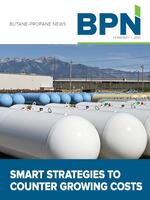
In mid-January, we asked other frequent contributors to BPN to comment on issues affecting the propane market. Find their insights below.
John Powell, Senior Vice President, MSL Group
Crestwood
“The biggest challenge we see is managing any fixed price commodity exposure,” said John Powell, senior vice president of Crestwood’s marketing, supply, and logistics (MSL) group (Kansas City, Mo.) “Right now, with the mild winter we are having—the field inventory balances along with pipeline, rail, and truck transportation capacity—we are not seeing any issues getting product to the consumer in the field.”
Powell encourages retail marketers to keep people in the field full to avoid any disruptions that may come in the future. “The market has been very efficient in managing inventory levels this year, as is evident by the lack of disruptions across the country,” Powell explained. Looking forward to next winter, “While I cannot comment on pricing, I would suggest to really start looking at next year’s programs, as the forward months for next year are much lower than the current spot values. So, something to consider might be looking at your marketing plans for next year.”
J.D. Buss, Trading and Risk Management Advisor
Twin Feathers Consulting
“Where are prices going in the Far East? That is not a question U.S. retail propane marketers have traditionally had any interest in, but it is becoming a big question now,” J.D. Buss, trading and risk management advisor at Twin Feathers Consulting (Overland Park, Kan.), pointed out. “If retail marketers are not tuning in now to the international propane market, they are missing out on huge factors that will affect prices here in the U.S.”
“In addition, paying attention to future estimates on inventory builds is important. Listen to the experts on expected builds as that will have a significant impact on pricing and availability going forward.”
Jeff Thompson, Supply Consultant
Propane Resources
“We are especially watching PADD II, which many associate with Conway, Kan., but it includes the territory up through the upper Midwest,” Jeff Thompson, supply consultant with Propane Resources (Mission, Kan.), noted. “With more exports going from both the U.S. and Canada, excess propane that has landed in this region in the past has other plans now for waterborne travel.”
He feels the potential in the future for Conway propane trading much higher than Belvieu is real if propane inventories get squeezed as they have a few times in the past decade. “It all depends on if Conway gets drained. Everyone needs to remain aware PADD II is more than Conway. ”
Anne Keller, Managing Director and Founder
Midstream Energy Group
“Propane’s success in growing global demand for lower carbon fuels and modern materials has balanced the market,” said Anne Keller, managing director and founder of Midstream Energy Group (Sugar Land, Texas). “The era for ‘cheap’ supply is coming to an end as growth rates for domestic supply slow and plateau.”
Keller sees several things to watch going forward. “U.S.–China relations will be the primary driver of what happens with energy transition initiatives,” she said. “Also, LPG as a replacement for diesel in the heavy freight market is gaining momentum.”
Steve Kossuth, Vice President of Global LPG Supply
UGI Corporation
Kossuth, who is vice president of global LPG supply at UGI Corp. (AmeriGas’ parent company), also serves as chairman of the NPGA Supply and Logistics Committee.
“We were pleased with participation in NPGA supply webinars last year and will provide more programs in the coming year,” Kossuth said. “Mother Nature is in control right now. As we’ve shared with marketers, the propane industry’s distribution system isn’t built for optimization during the coldest weeks of the year and we’ve all got to work together to be prepared and get product to our consumers as efficiently as we can during the cold periods. We tout key propane benefits as ‘safe, reliable, and affordable’ and we can’t afford to fall short of the benefits for our industry’s customers; our industry learned valuable lessons during the Polar Vortex in the winter of 2013-14.”
“We have indeed become an international market with exports to Asia and everywhere else ramping up,” he said. “While recently this drove prices up, it is important to keep in mind that the United States has some of the most affordable LPG values in the world; exports have enabled production increases over the last decade. At times, in sharp contrast, there are local U.S. markets where there may be some excess molecules at a discount to their historical norm. Looking at the futures market, there is steep backwardation going forward. Watch exports and inventory in weekly EIA data for signs of what may happen. My biggest hope is that propane marketers take a balanced view regarding risk, recognizing that mitigating risk often requires paying a premium for assurances of supply.”


